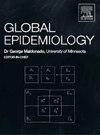Mpox: Characterization and clinical outcomes of patients in Colombian healthcare institutions
引用次数: 0
Abstract
Introduction
In 2022, the world experienced a monkeypox outbreak caused by the Clade IIb strain of the virus. While this outbreak had widespread effects, more information is needed on mpox's specific impact in Colombia, particularly regarding how it is managed, its burden, and its epidemiology. This research seeks to examine the medical context, clinical presentation, and health outcomes of individuals diagnosed with mpox infection, with a particular focus on those with HIV in Colombia.
Methods
This retrospective study was conducted in fourteen Health institutions in Colombia based on computerized clinical records from Jan 2022 to Dec 2023. Clinical and epidemiological characteristics were collected from diagnosis until discharge (or death). Participants in the study were diagnosed through molecular methods (PCR) and their clinical evolution was tracked through hospital and/or outpatient medical records. Registered variables were based on the mpox 2023 Case Report Form (2023 - CRF) proposed by the World Health Organization.
Results
One thousand four hundred thirteen (1413, 97.2 % male) individuals, including 2.6 % identified as healthcare workers, were included in this study. The majority (54 %, 764/1413 individuals) were persons living with HIV (PWH) and almost one-third of them (30.1 %, n = 284) of participants had concomitant sexually transmitted diseases and HIV, with syphilis being the most prevalent (20.4 %), followed by Neisseria gonorrhoeae (16.4 %). Complications were infrequent, with cellulitis being the most common, and no individuals received mpox-specific treatment or vaccination. Although all individuals had skin lesions distributed across various body regions, differences were noted in lesion distribution among women. Those living with HIV showed higher emergency department attendance and reported having known mpox contacts. While complications were rare, with cellulitis being the most common, women living with HIV showed a higher rate of emergency room visits and known mpox contacts. Although not statistically significant, gastrointestinal, musculoskeletal, psychological, respiratory, and STI symptoms, including syphilis and urethritis, were more common in the virologically non-suppressed HIV group. At the same time, proctitis was more prevalent in the suppressed group. No significant differences were found based on CD4 count, using 200 cells/mm3 in PWH.
Conclusion
Over half of the participants were people living with HIV (PWH), with a significant presence of STIs like syphilis. While skin lesions and complications varied, no significant differences were linked to CD4 count or viral load suppression. Mpox symptomatology was not significantly associated with unsuppressed viral loads or low CD4 levels, highlighting the need for further research.
Mpox:哥伦比亚卫生保健机构患者的特征和临床结果
在2022年,世界经历了由IIb进化枝毒株引起的猴痘疫情。虽然这次暴发产生了广泛的影响,但需要更多地了解mpox在哥伦比亚的具体影响,特别是关于如何管理、负担和流行病学方面的信息。本研究旨在检查诊断为m痘感染的个人的医学背景、临床表现和健康结果,特别关注哥伦比亚的艾滋病毒感染者。方法基于2022年1月至2023年12月在哥伦比亚14家卫生机构的计算机临床记录进行回顾性研究。收集从诊断到出院(或死亡)的临床和流行病学特征。该研究的参与者通过分子方法(PCR)进行诊断,并通过医院和/或门诊医疗记录跟踪其临床演变。注册变量基于世界卫生组织提出的mpox 2023病例报告表(2023 - CRF)。结果共纳入1413人(男性占97.2%),其中卫生保健工作者占2.6%。大多数(54%,764/1413人)是艾滋病毒感染者(PWH),其中几乎三分之一(30.1%,n = 284)的参与者同时患有性传播疾病和艾滋病毒,其中梅毒最普遍(20.4%),其次是淋病奈瑟菌(16.4%)。并发症很少,蜂窝织炎是最常见的,没有个体接受过mpox特异性治疗或疫苗接种。尽管所有个体的皮肤病变分布在不同的身体区域,但在女性之间的病变分布存在差异。那些感染艾滋病毒的人在急诊室的出勤率更高,并报告有已知的麻疹接触者。虽然并发症很少,蜂窝织炎是最常见的,但感染艾滋病毒的妇女急诊室就诊率和已知的m痘接触率较高。虽然没有统计学意义,但胃肠道、肌肉骨骼、心理、呼吸和性传播感染症状,包括梅毒和尿道炎,在病毒学上未被抑制的HIV组中更为常见。同时,抑制组的直肠炎发生率更高。在PWH中使用200个细胞/mm3的CD4计数未发现显着差异。超过一半的参与者是艾滋病毒感染者(PWH),有明显的性传播感染,如梅毒。虽然皮肤病变和并发症各不相同,但与CD4计数或病毒载量抑制没有显著差异。m痘症状与未抑制的病毒载量或低CD4水平无显著相关性,这突出了进一步研究的必要性。
本文章由计算机程序翻译,如有差异,请以英文原文为准。
求助全文
约1分钟内获得全文
求助全文

 求助内容:
求助内容: 应助结果提醒方式:
应助结果提醒方式:


